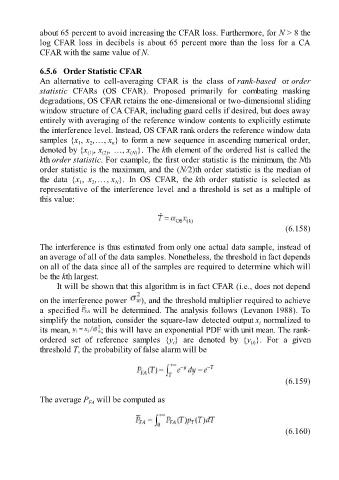Page 523 - Fundamentals of Radar Signal Processing
P. 523
about 65 percent to avoid increasing the CFAR loss. Furthermore, for N > 8 the
log CFAR loss in decibels is about 65 percent more than the loss for a CA
CFAR with the same value of N.
6.5.6 Order Statistic CFAR
An alternative to cell-averaging CFAR is the class of rank-based or order
statistic CFARs (OS CFAR). Proposed primarily for combating masking
degradations, OS CFAR retains the one-dimensional or two-dimensional sliding
window structure of CA CFAR, including guard cells if desired, but does away
entirely with averaging of the reference window contents to explicitly estimate
the interference level. Instead, OS CFAR rank orders the reference window data
samples {x , x ,…, x } to form a new sequence in ascending numerical order,
2
1
n
denoted by {x , x , …, x }. The kth element of the ordered list is called the
(1)
(2)
(N)
kth order statistic. For example, the first order statistic is the minimum, the Nth
order statistic is the maximum, and the (N/2)th order statistic is the median of
the data {x , x ,…, x }. In OS CFAR, the kth order statistic is selected as
N
1
2
representative of the interference level and a threshold is set as a multiple of
this value:
(6.158)
The interference is thus estimated from only one actual data sample, instead of
an average of all of the data samples. Nonetheless, the threshold in fact depends
on all of the data since all of the samples are required to determine which will
be the kth largest.
It will be shown that this algorithm is in fact CFAR (i.e., does not depend
on the interference power ), and the threshold multiplier required to achieve
a specified will be determined. The analysis follows (Levanon 1988). To
simplify the notation, consider the square-law detected output x normalized to
i
its mean, ; this will have an exponential PDF with unit mean. The rank-
ordered set of reference samples {y } are denoted by {y }. For a given
i
(i)
threshold T, the probability of false alarm will be
(6.159)
The average P will be computed as
FA
(6.160)

